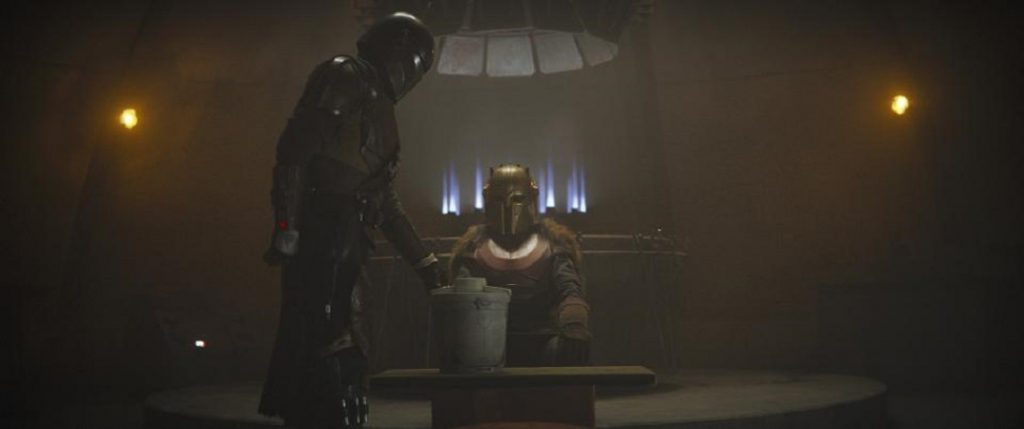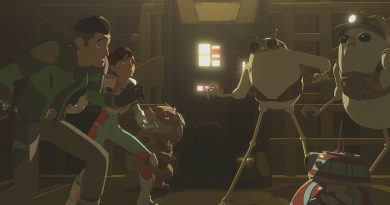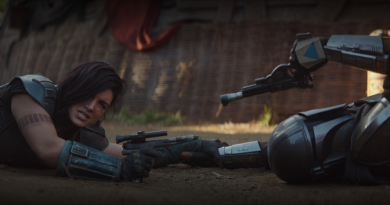Star Wars The Mandalorian – The Sin Review
“The Sin” is the ominous title of The Mandalorian’s third episode and sets up a question that is never clearly answered. What is the sin? A sin indicates behavior that violates a preconceived set of rules, and our helmed hero decides on at least three occasions to cross that invisible line. In the process, director Deborah Chow’s episode emerges as the strongest yet in Jon Favreau’s live action Star Wars. Likewise, quite appropriately for being Favreau’s creation, the episode also dives deeper into the Mandalorian lore of the post-Galactic Empire universe.
It begins with the Mandalorian’s first sin, the betrayal of trust placed in him by, for want of a better term, baby Yoda. The fifty-year-old child had essentially saved his life in the previous episode, and the Mandalorian immediately takes his bounty to the Client. The Mandalorian later aptly refers to the child as an enemy who did not know he was the Mandalorian’s enemy (or truly, vice versa). Herzog’s Client ecstatically accepts the child, who is ushered out of the room with a lasting glance back at its former protector, in exchange for a camtono full of beskar steel. For a moment, the Mandalorian commits a second sin: asking the Client what will happen to the child, a violation of the bounty hunter rules. An irritated Client reminds him of such and sends him on his way. His hand heavy with payment, and perhaps his conscience heavy, too, the Mandalorian returns to the Armorer with the steel.
There another Mandalorian (voiced by Jon Favreau and named Paz Vizsla in the credits) calls out the protagonist’s Imperial stamped beskar steel as being impure. It’s a sin, essentially, to use such tainted material to craft the armor of a Mandalorian. Words leads to blows, which leads to knives drawn and ready. Then the Armorer, the commander and spiritual leader of the covert (as we learn later, the group is called) intercedes and essentially claims that the process of forging will purify the metal. In short, an action will redeem a wrong.
In the same scene we learn of “The Way,” the guiding principle for the Mandalorians, at least these Mandalorians, in the chaotic times of the New Republic. The Way, all in all, is probably the silliest construct of the entire show, created more to establish at atmosphere and feeling of secrecy and hiding among the armored warriors than to make a lot of sense. For example, never removing your helmet: why not? Beyond the hygienic and eating logistics involved, why is it dangerous for a Mandalorian to remove their helmet even amongst themselves? Not to mention, this is in complete contradiction to the Mandalorians we have previously seen in canon in The Clone Wars and Rebels. Another command: only one Mandalorian may be out and about while everyone else stays underground. First, this at least indicates the important role bequeathed to our protagonist, the chief out and abouter. Second, however, it implies that the Mandalorians want to conceal their numbers, but again, here is an example of not thinking through what you are writing. Every Mandalorian we see in the show so far has had unique armor; thus, even if they take turns going out and about, it’s plainly obvious that there are different Mandalorians present in the area. The Way is probably the weakest element of the writing so far because it’s decorated with such pretentiousness, but struggles to survive just an elementary scrutiny. It gets a pass, however, because of the strength of the episode around it.

After another forging scene with additional flashbacks, confirming that those memories occur during the Clone Wars with the full reveal of a B2 battle droid (see Attack of the Clones or The Clone Wars for more on those clankers), the Mandalorian takes his new set of armor and returns to the Bounty Hunters’ Guild looking for another job. Realistically, he’s looking to move beyond the last job, something that we quickly learn he’s unable to do. He returns to the hideout of the Client in search of knowledge of the child. In a dumpster behind the building, he finds the child’s space bassinet callously discarded by individuals who no longer see a need to care for baby Yoda. It’s enough to send the Mandalorian into the building in full on killing mode to find and rescue his former bounty.
It’s been established that the Mandalorian is an excellent fighter and the well shot and choreographed fight scenes do nothing to undermine this image. One after another, he takes out the Client’s stormtroopers until he finds the child, alive, in the custody of a frantic Dr. Pershing. Child in hand, the Mandalorian fights his way out of the Client’s den. Only moments later, he finds himself amid an angry hive of his fellow bounty hunters; he has committed the gravest sin of their profession – reneging on a bounty.
The odds are stacked against the Mandalorian as Carl Weather’s Greef Carga calls for him to surrender the child. While it’s possible the Mandalorian might have found some way out of the desperate situation, all is saved when his fellow Mandalorians come to his aid in a surprise attack from above. While Ludwig Görranson’s music has been amazing for the series so far, he shifts to a trumpeted fanfare for the arrival of the other Mandalorians, which somehow simply feels out of place for the series’s overwhelmingly spartan score. Music aside, the Mandalorian is forgiven for exposing his covert, to which he’s simply told once more “This is The Way,” presumably meaning to come help him. With baby Yoda in arm, the Mandalorian hops aboard his Razor Crest, gives Greef a close call with death, and flies off into the stars. Like the beskar steel reclaimed from the Purge, he finishes the episode redeemed from at least one of the sins committed at the beginning: the one of betraying his little green bounty through his actions.
As previously noted, “The Sin” was directed by Deborah Chow, who did not have the benefit of the open, impressive offworld vistas granted to the series previous directors, or even to a setting that lent itself to eye catching settings or scenes. A good two-thirds of the episode are set inside dimly lit areas, including the Mandalorian covert, the favored cantina of the bounty hunters, or the Client’s post-Imperial den. Through it all, however, she succeeds in crafting a story that kept eyes glued to the screen, succeeding despite such a visual burden.
The absence of women, outside of the Armorer, remains a glaring problem that will hopefully be remedied by the show’s second woman director, Bryce Dallas Howard, and the introduction of Gina Carano’s Cara Dune. It’s presence, however, in this day and age, is unforgivable given the ease with which simple casting choices could have been made (such as allowing a woman to voice a stormtrooper). Once The Mandalorian begins to balance out it’s representation, it will truly be one of the best shows in this galaxy.
- Star Wars The Mandalorian – The Reckoning and Redemption Review - January 15, 2020
- Star Wars: The Mandalorian –The Prisoner Review - January 11, 2020
- Star Wars Resistance – Station to Station Review - January 7, 2020











